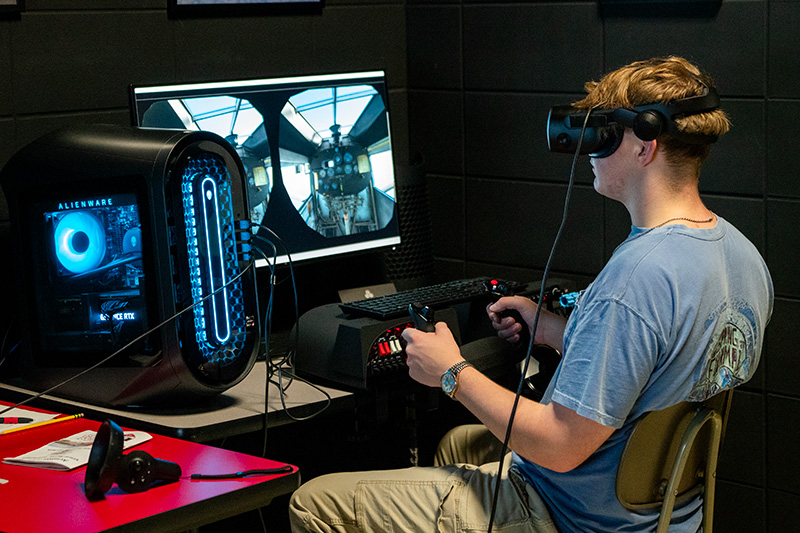Breadcrumb
Aviation Students, Faculty to Simulate 1919 Great Air Race as a Fundraiser
By Jeff Murphy, November 6, 2023

Treyton Culp, a University of Central Missouri freshman Aviation-Professional Pilot
major from Rolla, Missouri, takes a turn behind the controls of the virtual reality
flight simulator, Spirit of St. Louis, which will be used to help to re-create virtually
the first transcontinental air race.
WARRENSBURG, MO – “The Great Air Race: Glory, Tragedy and the Dawn of American Aviation,”
is a recent book by journalist and amateur pilot John Lancaster about America’s famous
1919 transcontinental air race. The story of that race has inspired a group of University
of Central Missouri aviation students and their faculty advisor to develop a virtual
re-creation of the groundbreaking, cross-country flight that captured the world’s
attention over 100 years ago. The virtual re-creation is intended to bring renewed
awareness to this piece of trailblazing American history while also raising funds
to support student activities.
David Jupp, assistant professor in the UCM Department of Aviation, recently met with
representatives of four aviation student groups to plan the event, Jan. 14-20, 2024,
leveraging flight simulation equipment in the Virtual Reality lab at the T.R. Gaines
Technology Building. Student groups involved will begin seeking funds from individual
donors in November.
Contributions will be based on financial support for virtual fuel vouchers that would
cover the estimated per-gallon cost of fuel (at today’s prices) to fly a single-engine
airplane from Long Island, New York to San Francisco, California. Fuel use is calculated
virtually by the flight simulator, and it is estimated that at least 200 gallons of
fuel will be needed to make the trip. Each team will seek to raise at least $1,000
to cover their fuel cost with contributions going to support student organization
activities.
“If a group doesn’t get the full 200 gallons, they can start the race, but will only
get as far as the fuel will take them,” Jupp said. “So, if a team is stranded in Omaha,
for example, maybe someone could write them a check for whatever it takes to finish
the race.”
Students entering the race will keep a flight log and track their fuel usage virtually.
The flight simulators will give the students the opportunity to complete the trek
in Cessna 172s, the same airplane they train with at the Max B. Swisher Skyhaven Airport.
That flight simulation experience will serve to enhance their perspective and appreciation
of the modern Cessna 172 versus the ill-suited DH-4s and Fokker aircraft of the early
1900s. Team members are seeking Bachelor of Science degrees in the Professional Pilot,
Aviation Management, and Airport Management programs. Unlike those earlier aviators
who put their lives in danger to participate in the 1919 air race, the students’ single-engine
aircraft will be flown virtually, with the simulators also creating virtual, realistic
situations in which the student pilots must respond.
Jupp said each team will schedule blocks of time each day from Jan. 14-20 to fly the
route. Teams competing include Alpha Eta Rho, Women in Aviation, American Association
of Airport Executives/Missouri Airport Managers Association (AAAE/MAMA), and the UCM
Flight Team.
“We will post each team’s progress on the aviation department’s Facebook page, so
alumni, friends, family or whoever donated money can look at the page and see where
the team has been,” Jupp noted.
He believes this event is an opportunity to celebrate a piece of aviation history
that often gets overlooked. Although Jupp has worked more than 40 years in aviation,
he said reading the 2022 book, “The Great Race,” and learning more about its impresario,
Brigadier General Billy Mitchell, shed new light on the importance of this event that
took place more than a century ago.
“The Great Air Race” details the thrilling contest that was sparked by the vision
of Mitchell, who believed that the nation’s future rested on its ability to embrace
aviation in ways that were unimaginable to many Americans at the time. The headline-grabbing
spectacle he promoted began on Oct. 8, 1919 with 60 military pilots who competed to
be the fastest person to fly round trip from coast to coast. Behind the controls of
flimsy war-surplus airplanes with crude instruments and unreliable engines, only eight
daring aviators finished the 5,400-mile round-trip journey.
Through the race, Mitchell blazed a trail for the first formal air route across the
nation and inspired a coast-to-coast airmail service on the same flight path. However,
his hope for bolstering federal spending for an independent Air Force that would exist
along with the Army and the Navy fell short. That vision would not be realized until
Sept. 18, 1947 when the Department of the Air Force was created under the National
Security Act.
Comments about the value of this historic aviation event were shared on the back cover
of “The Great Air Race” by Pulitzer Prize-winning journalist Glenn Frankel. He noted,
“In narrating the story of the great 1919 air race, John Lancaster is also describing
the birth of arguably the single most enduring technological breakthrough of the twentieth
century, one that still wields enormous power over our daily lives and the fate of
the world.”
Individuals who want to learn more about the UCM aviation students’ virtual Great
Air Race are encouraged to contact Jupp at 660-543-4457 or jupp@ucmo.edu.








